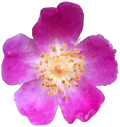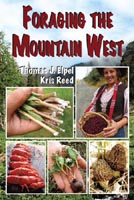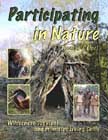|

Brassicaceae
Plants of the Mustard Family
(Previously known as Cruciferae)
Mustard flowers are easy to recognize. If you have a radish or turnip blooming in the garden, then take a close look at the blossoms. When identifying flower parts, it is best to start on the outside of the flower and work towards the middle like this: sepals, petals, stamens, and pistil(s).
On the outside of the mustard flower you will see 4 sepals, usually green. There are also 4 petals, typically arranged like either the letters "X" or "H". Inside the flower you will see 6 stamens: 4 tall and 2 short. You can remember that the stamens are the male part of the flower because they always "stay men". The female part is the pistil, found at the very center of the flower.
 For the purposes of the Mustard family, all you need to remember is "4 petals with 6 stamens--4 tall and 2 short". If you find that combination in a flower, then you know it is a member of the Mustard family. Worldwide there are 375 genera and 3200 species. About 55 genera are found in North America.
For the purposes of the Mustard family, all you need to remember is "4 petals with 6 stamens--4 tall and 2 short". If you find that combination in a flower, then you know it is a member of the Mustard family. Worldwide there are 375 genera and 3200 species. About 55 genera are found in North America.
All species of Mustard are edible, although some taste better than others. In other words, it doesn't matter which species of mustard you find. As long as you have correctly identified it as a member of the Mustard family, then you can safely try it and see if you want it in your salad or not.
 Most members of the Mustard family are weedy species with short lifecycles like the radish. Look for them in disturbed soils such as a garden or construction site, where the ground is exposed to rapid drying by the sun and wind. The Mustards sprout quickly and grow fast, flowering and setting seed early in the season before all moisture is lost from the ground.
Most members of the Mustard family are weedy species with short lifecycles like the radish. Look for them in disturbed soils such as a garden or construction site, where the ground is exposed to rapid drying by the sun and wind. The Mustards sprout quickly and grow fast, flowering and setting seed early in the season before all moisture is lost from the ground.
Also be sure to look closely at a Mustard seedpod, called a silicle or silique, meaning a pod where the outside walls fall away leaving the translucent interior partition intact. They come in many shapes and sizes, as you can see in the illustration, but they always form a raceme on the flower stalk, which looks something like a spiral staircase for the little people. With practice you can easily recognize the mustards by their seed stalks alone, and from fifty feet away. Identification by the seed stalks is helpful since many of the flowers are too small to peer inside and count the stamens without a good hand lens.
Interestingly, six of our common vegetables--cabbage, cauliflower, kohlrabi, Brussels sprouts, broccoli, and kale--were all bred from a single species of mustard, Brassica oleracea. Plant breeders developed the starch-storage abilities of different parts of the plant to come up with each unique vegetable. Commercial mustard is usually made from the seeds of the black mustard (B. nigra) mixed with vinegar.
As you become more familiar with this family, you will begin to notice patterns in the taste and smell of the plants. While each species has its own unique taste and smell, you will soon discover an underlying pattern of mustardness. You will be able to recognize likely members of the family simply by crushing the leaves and smelling them.
Key Words: 4 petals and 6 stamens--4 tall and 2 short.

Alyssum simplex. Wild Alyssum. |  Arabis holboellii. Holboell's rockcress. |

Arabis sp. Rockcress. |  Arabis sp. Rock cress. |

Lepidium draba. Whitetop Hoary Cress. | 
Lepidium draba. Whitetop Hoary Cress. Introduced and sometimes invasive. [Read more.] |

Lepidium montanum. Mountain Pepperweed. | 
Lepidium montanum. Mountain Pepperweed. Grand Staircase-Escalante National Monument. Utah. |
 Lepidium perfoliatum. Clasping Pepperweed. An introduced, edible weed from Europe. |
 Draba sp. Whitlow Grass. Lewis and Clark Caverns State Park, Montana. |
 Draba sp. Whitlow Grass. Lewis and Clark Caverns State Park, Montana. |
 Draba sp. Whitlow Grass. Lewis and Clark Caverns State Park, Montana. |
 Barbarea orthoceras. American Wintercress. |
 Barbarea orthoceras. American Wintercress. |
 Sisymbrium altissimum. Tumble Mustard. |
 Sisymbrium altissimum. Tumble Mustard. The tender tops taste a bit like broccoli, but more spicy. |
 Sisymbrium loeselii. Small Tumble Mustard. |
 Sisymbrium loeselii. Small Tumble Mustard. |
 Erysimum capitatum. Western Wallflower. |  Erysimum sp. Wallflower. Near Denver, Colorado |
 Hesperis matronalis. Sweet rocket. Escaped from cultivation. |  Hesperis matronalis. Sweet rocket. Pony, Montana |
 Nasturtium officinale. Watercress. Introduced from Eurasia. Watercress is most often found water from fresh water springs, where it continues to grow all winter long, no matter the weather above the water. |  Nasturtium officinale. Watercress. A delicious, spicy edible plant for salads or soups. |
 Physaria newberryi. Newberry's Twinpod. Arizona. |  Physaria didymocarpa. Twinpod. Ruby Range. Near Alder, Montana. |
 Lesquerella sp. Bladderpod. Arizona. |  Stanleya pinnata. Prince's Plume. Lake Powell. Utah. |
-Also see these West Coast members of the Mustard Family-
- Cakile edentula Sea Rocket. Photographed along the Oregon-California coast.
- Raphanus sativus. Wild Radish. Escaped from cultivation. Photographed along the northern California coast.
|
There are more
Mustard Family pictures
at PlantSystematics.org.
Return to the Plant Families Index
Return to the Wildflowers & Weeds Home Page
|





 Most members of the Mustard family are weedy species with short lifecycles like the radish. Look for them in disturbed soils such as a garden or construction site, where the ground is exposed to rapid drying by the sun and wind. The Mustards sprout quickly and grow fast, flowering and setting seed early in the season before all moisture is lost from the ground.
Most members of the Mustard family are weedy species with short lifecycles like the radish. Look for them in disturbed soils such as a garden or construction site, where the ground is exposed to rapid drying by the sun and wind. The Mustards sprout quickly and grow fast, flowering and setting seed early in the season before all moisture is lost from the ground. 
































